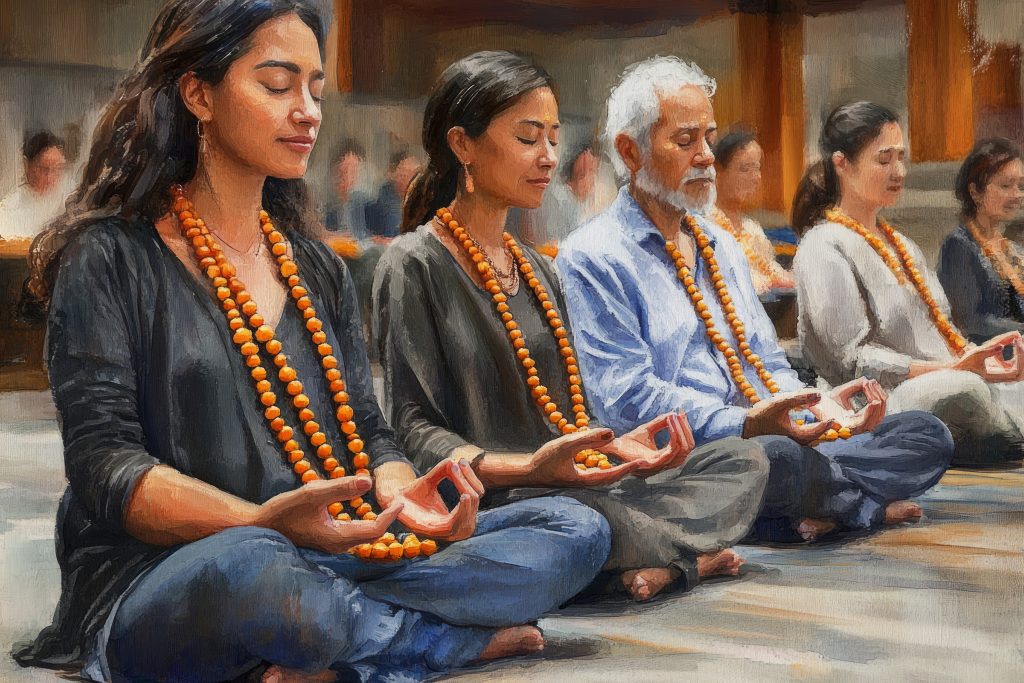Yogacharya Dr Ananda Balayogi Bhavanani, Editor
Practicing Yoga with awareness and consciousness enables individuals to experience the joy of living a happy and healthy life on all levels. Yoga offers tools to become more aware of the body and mind, and connect to the inner-self.

Recently, I had a discussion on honoring Yoga through cultural appreciation at the International Association of Yoga Therapists (IAYT). It was truly an inspiring and insightful conversation. Many beautiful concepts and essential pointers were raised. The focus was on a crucial and heartfelt topic — how we can move from cultural misappropriation toward genuine cultural appreciation, especially within the practice and therapeutic application of Yoga. Many beautiful points were shared in this discussion. One clear theme emerged: to truly appreciate, one must be mindful of context, acknowledge the source, and drink straight from the living traditions of Yoga — not from a packaged version. We must keep Sanskrit alive in Yoga, keep India alive in Yoga, and honor the cultural ethos, especially when moving into Yoga research and therapy. Yoga’s roots lie in Sanatana Dharma and the living culture of Bharat (India). Recognizing, loving, valuing, and respecting this source in thought, word, and deed is essential.
The act of appreciating a culture involves actively cultivating its growth and development, mirroring the processes observed in horticulture, agriculture, and even microbiology, where nurturing and tending lead to flourishing. Culture, after all, means a living, growing tradition. Like agriculture grows crops, culture grows consciousness. India’s ancient culture is vibrant, alive, and evolving, not something to be boxed up in a museum. Yoga is an integral part of this living tradition. When Yoga is stripped from its cultural context, you have the body without the soul. The essence of cultural appreciation lies in recognizing and respecting the profound wisdom embedded within ancient traditions, not only from India but also from diverse cultures across Asia, South America, and Africa, where unique and invaluable teachings have been cultivated over millennia. It’s important to understand that culture is not something fixed or frozen in time. It is always growing, changing, and evolving. This is especially true for India, whose culture cannot be neatly put into a box or fully captured in textbooks or museums. Indian culture is alive—it continues to breathe, adapt, and transform with time, while still holding on to its deep roots and ancient wisdom.
Cultural misappropriation happens when religious symbols end up as fashion fads or teachings are repackaged without acknowledging their origin. Rudraksha beads, saris, and Sanskrit chanting are not props, but spiritual components with significant meaning and obligation. Wearing a Rudraksha isn’t about looking cool; it’s about living with reverence in your thoughts, words, and actions. Yoga, as a way of life, encourages the development of qualities such as compassion, empathy, and love, while diminishing the influence of ego-centric tendencies. The transformative potential of Yoga is intertwined with the purification of consciousness, wherein mental processes are reshaped and restructured, leading to a profound transformation of the mind and its functions. This transformation allows individuals to gain a deeper understanding of themselves and their place in the cosmos, fostering a sense of interconnectedness and unity.
When someone outside of India loves Indian culture, learns its language, wears its clothing with devotion, and respects its traditions, it is not misappropriation, but rather sincere appreciation. Sir John Woodroffe, for example, who studied Tantra and Sanskrit, is admired rather than criticised. Culturally appropriate Yoga involves embracing the teachings, honouring their source, using cultural symbols with awareness, and embodying the Yoga spirit. Academic integrity teaches us to cite sources, and Yoga demands cultural integrity. Today’s challenge is not about race or nationality—not white against brown, Indian versus non-Indian. It is about dharma —the ‘right-usefulness’. Yoga, being a gift of Sanatana Dharma, nourishes all pure hearts, regardless of its source. Yoga transcends all boundaries when practiced with love, respect, and an intention to live its truth.
To nurture this sacred awareness and encourage sincere seekers to understand Yoga more deeply, I am humbled to offer a special learning opportunity on this International Yoga Day 21st June 2025: the “Yoga and Cultural Appreciation” course, lovingly coordinated by Yogachemmal Nilachal Padmashanti.
This offering is not merely a course, but a heartfelt invitation to explore the cultural, historical, philosophical, and spiritual dimensions of Yoga. Together, we will engage with the richness of Sanskrit, the integrity of sacred teachings, the significance of symbols, and the ethical responsibilities of sharing Yoga in today’s world. This is not about certificates; this is about commitment to the culture of Yoga. It is a humble movement toward reclaiming the cultural integrity and spiritual soul of Yoga. It is a movement toward culturally appropriate Yoga. It is a way to ensure that Yoga continues to live, not just as a practice, but as a living tradition.
Yoga is our Mother. We are her children, and it is our sacred duty to protect her, nurture her, and honor her. Integrity, fidelity and commitment to Yoga is of great significance. When we have that and we have love and respect for the culture, it is totally culturally appropriate Yoga.
Love Yoga! Live Yoga! Let it manifest in every cell of your being.
Let’s honor our Divine Mother—Yoga—with all that we are.